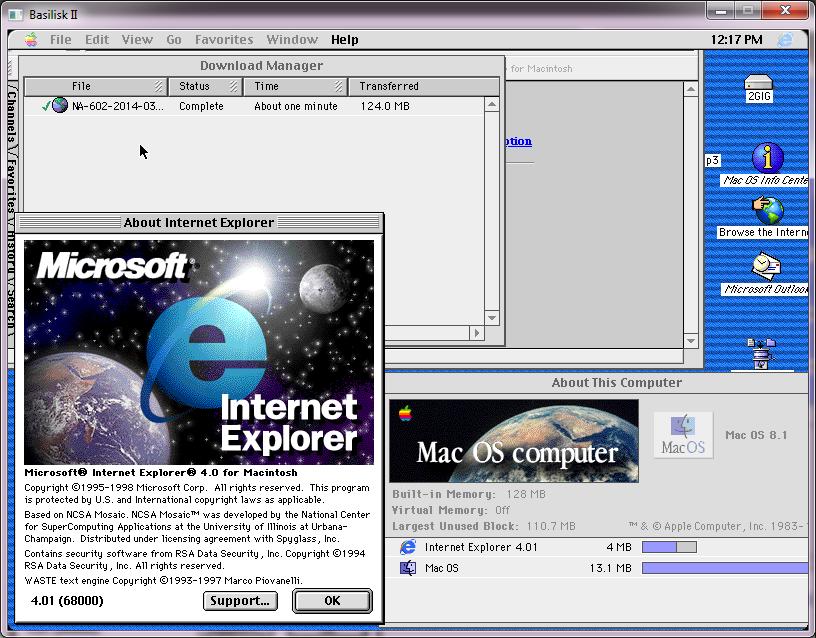I’ve been busy at work, but I did get some stuff done on this over the weekend, and just wanted to push this version out while there is some momentum.
The big fixes are in SCSI to support the dynamic scatter gather buffers so you can format big (lol) disks. Â Then again I only tested a 2GB disk but it’s working fine as far as I can tell.
I also hard coded SCSI id #6 as a CD-ROM. Â It only reads HFS partitioned images, and only can boot from a handful of those. Â From some SCSI CD emulation packages with passthru it performs just as poorly, so it’s not just me. Â I tested with the ‘blessed’ Win32 build 142, with ForceASPIÂ in a Windows XP VM with emulated SCSI CD. Â There is a lot more ‘magic’ going on with the cdenable.sys driver on the Windows side, which mounts ISO’s without any hesitation.
This also includes my latest networking fixes as I moved more of the networking code to use queues, forced the 60Hz timer to hit the network card so it won’t stall anymore, and added in that timer patch, that more than doubled my LAN download speeds.
I’ve also added a simple PCAP filter as I noticed that my LAN was quite chatty, and I figured all this traffic wouldn’t be good as an emulator really shouldn’t be processing stuff it doesn’t need to. Â Something like this:
(((ether dst 09:00:07:ff:ff:ff) or (ether dst ff:ff:ff:ff:ff:ff) or (ether dst fe:fd:00:00:16:48)))
09:00:07:ff:ff:ff is the AppleTalk broadcast address, ff:ff:ff:ff:ff:ff is the typical all hosts broadcast, and I’m still generating a MAC based on PID which is good enough for me.
So while before downloading 124MB on my LAN took 8 minutes, now it’s about a minute.
I’ve updated the sourceforge page with source, Win32, Linux i386 and OS X (10.8) builds. I’ll add a 10.6 x86/PowerPC build later. Â On the sourceforge page I also added a utilities section with a simple ISO image with various utilities to get you started, including the A/UX partitioning tool to partition & format a virtual disk, a tool to try to mount ISO’s (remember HFS has the only hope right now), QuickTime, Flash, Internet Explorer and some other stuff.
Also, thanks to Peter, it’s also available on github, so my horrific edits are open for the world to see…


I hope you don’t mind, but I’ve mirrored your releases up at Github https://github.com/pgodwin/CockatriceIII. I’m hoping at some point I can find time to have a play as well.
no not at all!
I see you’ve extracted the source. Is there some idiots 3 minute guide to git? I couldnt’ figure it out and felt my time was better spent doing more testing/debugging.
I see you have the version stuff in there, which is cool I was hoping to start off from 0.8 before I starting messing with it. But I’m not complaining now I can see the damage I’ve done! 🙂
No quick guide I’m aware of (I had a steap learning curve on it myself), but I think you can also use SVN clients with Github if you’re used to SVN. Otherwise, github themselves have a very easy to use client, or I’ve used “Git Extensions” under Windows at work without issue.
I was hoping to try and fork Basilisk II from 0.8 and commit the changes from there but I wasn’t exactly sure which commit married up with the 0.8 release. Besides, I doubt anyone would be silly enough to try and merge the current Basilisk II tree with Cockatrice!
That said I can probably sneak in a 0.8 dump so we can just see your changes between 0.8 and 0.0 of cockatrice…leave it with me.
More so that I can see what I changed going forward so I can easily check which direction I’ve changed stuff or things I’ve gutted but may want to revisit like the clipboard.
It may seem silly but 0.8 is where all of this came from.
It took me over a day to get CVS working in some fashion that I had wanted to look for stuff in DOOM. But I haven’t kept up in CVS replacements. And apparently sourceforge doesn’t do CVS anymore.